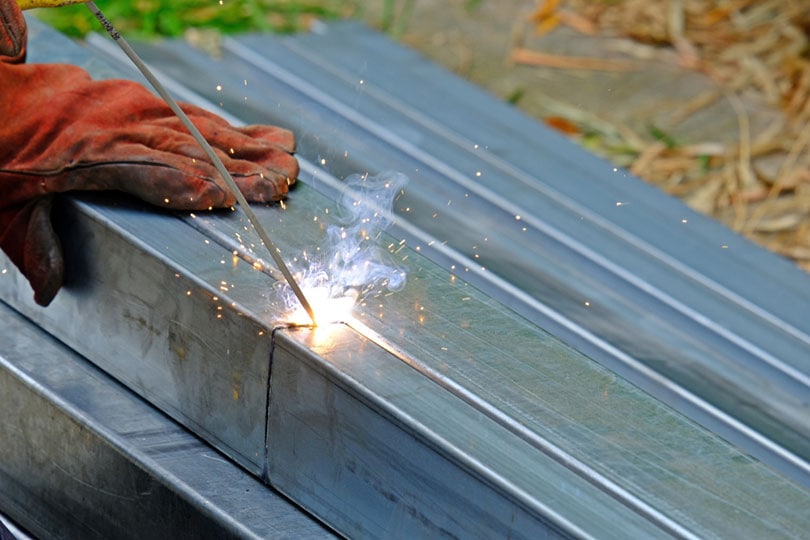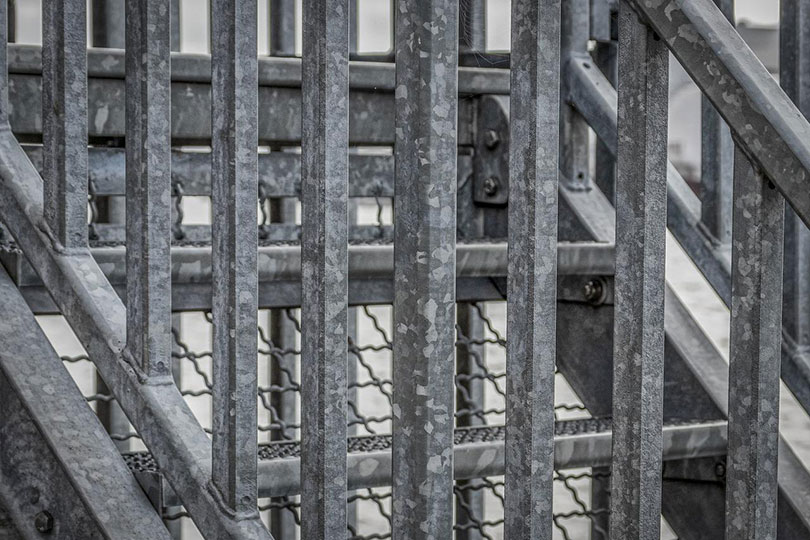Can You Weld Zinc? The Surprising Answer!
Last Updated on

Zinc is one of the metals that are easy to work with but has limitations preventing it from being used in many applications. And although it is possible to weld it, it is considered to be a difficult task due to the properties of the metal.
It has a low melting point and is very reactive, making it challenging to work with. In addition, it produces fumes that can be harmful to your health, so it’s important to take precautions when welding it. The key to welding it is to use a filler metal that will melt at a lower temperature than the base metal. But if you can weld mild steel and stainless steel, you’ll have no trouble welding your first zinc structures.
If you’re just starting in welding and want to try your hand at welding zinc, then keep reading! We’ll talk about everything you need to know about welding zinc in this guide. Also, we’ll discuss several properties of zinc and the risks associated with welding it, not forgetting the suitable welding procedure.
Physical Properties of Zinc
Before attempting to weld zinc, it’s important to understand its physical properties, which come into play when welding.
In its pure form, zinc is a bluish-white metal. The metal can be used for galvanizing iron and steel. It is also used as an alloy with copper to produce brass and bronze alloys.
Here are several properties of zinc to keep in mind before you weld it.

Tensile Strength
Tensile strength is the force needed to break a material. It is determined by the maximum stress a material can withstand before it starts to deform. Zinc is not strong in this regard, but you can strengthen it by alloying it with other metals.
Weldability
Zinc is weldable. You will need to heat the zinc welds to a temperature above their melting point before welding. Do not use an open arc unless you are familiar with its characteristics and limitations. If you use an open arc, it’ll lead to surface damage.
You can perform zinc welding in all positions. The weld bead is more porous than that of pure metals. But you can reduce its porosity by selecting filler metals well and cleaning them after welding.
Conductivity
Zinc is a good conductor of electricity. But its conductivity is low compared to other metals. It’s still helpful as an electrical conductor.
The primary reason for this is that zinc has a high electrical resistivity. It means that it has a high ability to resist the flow of electrons through it.
It makes it helpful for electronic devices such as batteries. You can also use it in other applications where large currents are flowing through wires or connections.
https://www.instagram.com/p/BX6uhyVnk90/
Ductility
Ductility is the ability of a material to alter its shape without breaking or losing strength. The ductility of zinc metal allows it to be drawn out into wires or other shapes while retaining its original shape.
This property makes zinc helpful as an alloying agent in copper-zinc alloys, such as brass, bronze, and phosphor bronzes. The ductility also makes it helpful for coinage. It can be easily pressed into molds without breaking apart during production like other metals.
It’s also crucial to note that it becomes malleable and ductile at temperatures between 212º and 302º Fahrenheit. If the temperatures are raised, it becomes brittle.
- Related Read: Can You Weld Titanium? What You Need to Know!
Corrosion Resistance
Zinc is susceptible to corrosion from water and other chemicals. You must protect it against these elements if you use it for an application where corrosion is likely to occur. The corrosion resistance of zinc increases with increasing chlorine content in the environment. So, any chlorination in water that comes into contact with zinc will increase its corrosion rate.
What Is the Best Welding Method for Zinc?
The best technique for welding zinc is oxyacetylene welding. This process uses a mixture of oxygen and acetylene gas to create a hot flame that melts the metals you’re joining.
The resulting weld joint is stronger than the base metals. Besides, it’s less likely to break or corrode. The heat created by this process also causes any surface impurities on the zinc to burn off, improving the purity of your finished product.
Also, oxyacetylene can work at low temperatures compared to other welding gasses. Zinc needs lower temperatures than other metals.
While oxyacetylene welding is an excellent method for joining zinc, it’s not without its drawbacks. You need special equipment for this method. These include a torch and tanks filled with oxygen and acetylene gasses. You also need some experience to produce quality welds.

The 6 Steps How to Weld Zinc
Zinc can be welded with the same methods and equipment as steel, except that it needs preheating before welding and is more challenging to weld than steel.
It has a higher thermal conductivity and lower melting point. It is also sensitive to oxygen, which causes oxidation that can damage the metal.
Here are several steps to take when welding zinc.
1. Get Suitable Equipment
Make sure that you have all the necessary equipment before starting your project. This includes protective clothing as well as an appropriate welder for welding zinc. Your welding rod must be made from pure zinc.
2. Clean the Surfaces
Clean the surfaces you’re welding together. It means removing any dirt or debris from each side of the metal so that it does not interfere with the welding process. If there is moisture present on either side, it must dry off before proceeding with welding.
Use a wire brush to remove any remaining rust and paint from the metal. You can also use sandpaper to clean the metal surface.
3. Test Your Welds
Before you start welding, it’s an excellent idea to test the welds. You can use this practice to ensure your welding process is working well and that you are using a suitable technique for each type of metal.
It will also help determine if there are any flaws in your weld that need fixing before you proceed with the actual welding.
The idea behind this step is to ensure that there are no cracks or gaps in the joint that could affect its integrity after welding. Also, look out for any warping or cracking on the zinc.
https://www.instagram.com/p/BHP6GA3BUA6/
4. Tack Weld Your Zinc Pieces Together
Zinc is malleable and can bend easily. So, tack welding is a crucial step in ensuring that your weld joints remain strong after you have finished welding them together.
Make sure you don’t leave any gaps between pieces of metal that aren’t going to be welded together later. It will reduce the risk of cracks forming in your finished product when subjected to stress or pressure while it cools down after welding.
5. Weld the Joint
Once you’re done tack welding, weld the joint fully. You can use any filler rod for this metal as long as it has a similar composition to that of zinc.
The filler rod must also have an appropriate diameter for your application. This way, it can fill in gaps between two pieces of metal without leaving any voids behind when it cools down.
6. Grind and Polish the Welds
After completing the zinc welding process, use a belt sander or a grinding wheel to grind down rough spots or sharp edges. This way, they’re smooth and will appear professional.
Lastly, use a polishing compound or steel wool to polish your welds to make them shiny and attractive.
https://www.instagram.com/p/BQ2y2kFAuja/
Risks Associated with Welding Zinc
Welding zinc has its risks. Being a reactive metal, it can cause severe burns if you’re not careful. As mentioned earlier, always wear gloves, protective clothing, and eye protection.
Zinc also produces toxic zinc oxide fumes when it vaporizes. These fumes irritate the eyes, throat, and lungs. They may also cause headaches if inhaled in large quantities. Apart from headaches, zinc oxide fumes may also lead to:
- Arthralgia
- Chest tightness
- Fever
- Myalgia
- Sore throat
- Nausea
- Blurred vision
- Vomiting
It’s crucial to use a respirator always when welding it to avoid inhaling these fumes. If you’re working with a small amount of zinc, you can avoid fume exposure by wearing a damp cloth over your mouth and nose.
Safety Precautions to Take When Welding Zinc
- Wearing protective clothing such as gloves and a face shield or goggles.
- Work in a well-ventilated area away from welding sparks or flames.
- Do not wear loose clothing while welding because it could catch fire from sparks or hot metal particles. Wear long pants and sleeves made of flame-retardant material.
- Do not weld directly on concrete or any other non-metal surface. The heat generated by the flame may cause the concrete or other non-metal surface to crack or break apart.
- Keep away from open flames or red-hot objects. These flames can cause fires if welders accidentally drop sparks onto them.
Final Thoughts
Zinc is a difficult metal to weld due to its low melting point and reactivity. However, it is possible to weld it if you take the proper precautions. Be sure to use a lower power setting, use a short arc, and wear a respirator to protect yourself from the harmful fumes. With these tips in mind, you should be able to weld zinc successfully.
Featured Image Credit: Supratchai Pimpaeng, Shutterstock
